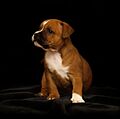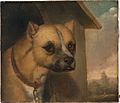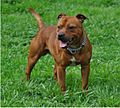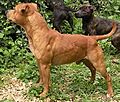Staffordshire Bull Terrier facts for kids
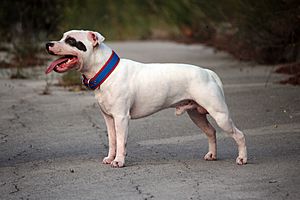 |
|||||||||||||||||||||||||||||||
| Common nicknames | Stafford Staffy | ||||||||||||||||||||||||||||||
|---|---|---|---|---|---|---|---|---|---|---|---|---|---|---|---|---|---|---|---|---|---|---|---|---|---|---|---|---|---|---|---|
| Origin | England | ||||||||||||||||||||||||||||||
| Foundation stock | Old English Bulldog Bull and terrier English White Terrier |
||||||||||||||||||||||||||||||
|
|||||||||||||||||||||||||||||||
| Domestic dog (Canis lupus familiaris) | |||||||||||||||||||||||||||||||
The Staffordshire Bull Terrier is a British dog breed. It is a medium-sized terrier with short hair. This breed started in the city of Birmingham and the Black Country area of Staffordshire, England. It was created by cross-breeding the Bulldog with the English White Terrier.
Originally, these dogs were bred for fighting. Before blood sports were made illegal in 1835, Staffords were used in activities like badger baiting, ratting, bull-baiting, and dog fighting. The Stafford is a descendant of the old bull and terrier cross, which was developed in England in the early 1800s.
Other breeds like the Bull Terrier, American Staffordshire Terrier, and American Pit Bull Terrier also come from these bull-type terrier breeds. They all share the Bulldog as a common ancestor. After blood sports were banned, people started to change how they viewed these dogs. Over many years, careful breeding turned the Stafford into a popular family pet and companion dog.
Because of its past as a fighting dog, it was hard for the Stafford to be recognized by the Kennel Club in the United Kingdom. However, it was finally added to their official list of purebred dogs in 1935. Staffords first came to North America in the late 1800s. But it wasn't until 1974 that the American Kennel Club accepted the Staffordshire Bull Terrier into their purebred registry.
Contents
What Makes a Stafford Special?
The Stafford is a strong, muscular, and very powerful dog. It is a small to medium-sized breed. They usually stand about 14 to 16 in (36 to 41 cm) tall at the shoulder. Male dogs typically weigh 29 to 37 lb (13 to 17 kg), and female dogs weigh 24 to 34 lb (11 to 15 kg).
Staffords have a wide chest and strong shoulders. Their legs are well-built and set wide apart. They have a medium-length tail that they carry low. Their head is broad with a short nose. Their ears fold over at the tips and are never cut short. The Stafford's coat is short, stiff, and lies close to its body. They can be red, fawn, white, black, or blue. They can also be any of these colors with white, or any shade of brindle (a striped pattern) with or without white.
A Stafford's Personality
Even when they were used for blood sports, Staffords were known as good family pets. Today, they are even more popular as companions. They are considered loyal, brave, and loving dogs. The Kennel Club even recommends them as suitable for families.
Staffords are known for being a bit feisty, especially if another dog challenges them. They usually won't back down from a challenge. It's a good idea for Stafford puppies to meet many different people and dogs when they are young. This helps them grow into well-behaved adults. Staffords are generally healthy and strong dogs. They can live for 12 to 14 years.
The History of the Stafford Breed
How Laws Changed Dog Sports
In 1835, the Cruelty to Animals Act 1835 made blood sports illegal in the UK. This law stopped bull and bear baiting, which needed large public areas. These large areas made it easy for police to stop the events. However, illegal dog fighting was harder to stop. Fight organizers often hid their events in private places like basements.
Because of this, dog fighting continued for a long time after bull and bear baiting ended. It wasn't until the Protection of Animals Act 1911 was passed that organized dog fighting in Britain mostly stopped.
How the Breed Developed
In the early 1800s, "bull and terrier" crossbreeds were created. People wanted dogs that could control pests and also be used in blood sports. In the mid-1800s, a man named James Hinks wanted to create a more refined dog. He wanted a dog that was brave but not overly aggressive, and that looked more elegant.
Hinks crossed the bull and terrier with the English White Terrier. This created a dog with better legs and a nicer head. Later, he also used the Dalmatian and Collie breeds. This led to the creation of an athletic white dog known as Hink's "white cavalier," which was the start of the modern Bull Terrier. However, many dog lovers preferred the original bull and terrier type. They stayed loyal to this type, which eventually became the modern Staffordshire Bull Terrier.
Ideas About Where Staffords Came From
The Stafford breed was developed in the area known as the "black country" of Staffordshire and northern parts of Birmingham. There are two main ideas about how the Stafford breed, as recognized by the Kennel Club, came to be.
The first and most common idea is that the Stafford, like the Bull Terrier, came from the now-extinct bull and terrier. This dog was a mix of the strong Old English Bulldog and the quick, feisty Black and Tan Terrier. The Old English Bulldog was bred for bear and bull baiting. It was also used in dog fights. But people realized that lighter, faster dogs were better for dogfighting than the heavier Bulldog. So, breeders mixed Bulldogs with local terriers to create a faster, more agile dog that still had the Bulldog's courage.
The second, less common idea is that the Old English Bulldog was not mixed with terriers. Instead, this theory suggests that the Stafford breed came directly from generations of selective breeding of early Bulldogs. This breeding produced a smaller, more athletic dog. Some people believe this theory is supported by how modern Staffords look similar to Old English Bulldogs in old paintings from the 1800s.
Staffords Around the World
After being recognized by the Kennel Club in the UK in 1935, the Stafford was later accepted by many other kennel clubs around the world. These include the American Kennel Club (AKC), which is the largest purebred dog registry in the world. Other clubs that recognize the Stafford are the Australian National Kennel Council (ANKC), Canadian Kennel Club (CKC), Irish Kennel Club (IKC), New Zealand Kennel Club (NZKC), and the United Kennel Club (UKC) in the United States.
Why Staffords Are Popular
Staffords are popular for several reasons. They are strong and agile, which makes them look tough. At the same time, they are loving, brave, and loyal family dogs that are friendly with people. A survey by Eukanuba found that Staffords and West Highland White Terriers are among the "most communicative and affectionate breeds." The survey also showed that Staffords are the "‘waggiest’ (80%) and most partial to a belly rub (62%)".
In 2019, ITV’s Britain's favourite dogs show named the Staffordshire Bull Terrier as the most popular dog breed in Britain. They are also very popular in countries like Australia, France, and New Zealand.
Because they are so popular, Staffords have faced some problems from too much breeding. In 2013, more than a third of the dogs at shelters like Battersea Dogs & Cats Home were Staffords. Sometimes, the breed has been linked to certain groups of people, which can lead to unfair negative ideas about the dogs themselves.
Images for kids
-
1876, The dog and its races. left column: English Mastiff, Dalmatian Shepherd Dog, Pug; right column: Danish Mastiff, Bull-dog
See also
 In Spanish: Staffordshire bull terrier para niños
In Spanish: Staffordshire bull terrier para niños






